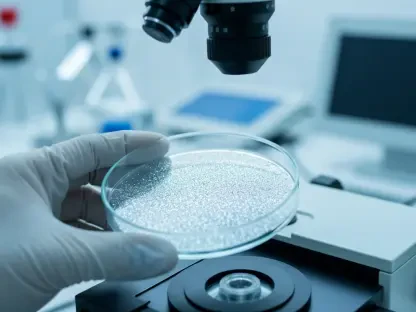Menstrual blood, often considered merely a byproduct of a natural biological process, is gaining attention as a potential source for health diagnostics. This innovative approach to using menstrual blood, rather than traditional venipuncture blood tests, opens new avenues for understanding and monitoring various health conditions. The rich biological information contained in menstrual blood could allow for a deeper and more comprehensive analysis of a person’s health status, transforming the way diagnostic data is collected and utilized. By tapping into this readily available resource, researchers are exploring how it can serve as a non-invasive alternative for detecting biomarkers linked to a variety of diseases. This innovative venture presents a promising opportunity to make health monitoring more accessible and less invasive, thereby potentially revolutionizing the approach to medical diagnostics.
Pioneering Research and Device Innovation
Leading the charge in this innovative research is Lucas Dosnon, a PhD candidate at ETH Zurich, who, along with his colleagues from Inge Herrmann’s lab, has made significant strides in harnessing menstrual blood’s diagnostic potential. They have developed a point-of-care testing device that can analyze biomarkers directly from menstrual blood collected within a sanitary pad. This innovative device bypasses the conventional need to send blood samples to a laboratory, as is required for standard venous blood tests. The development of this device represents a meaningful step toward more accessible health diagnostics, enabling individuals to monitor their health without the invasive process of traditional blood drawing.
The device, ingeniously designed, consists of a silicon casing that incorporates a lateral flow assay within a menstrual pad. This setup is capable of detecting specific biomarkers associated with various health conditions, providing a non-invasive method to assess health indicators without the cumbersome need for blood pre-processing. Dosnon’s venture, appropriately named MenstruAI, aims to further advance and commercialize this groundbreaking technology. Their research initially involved working with venous blood and adding precise quantities of known biomarkers like C-reactive protein (CRP), carcinoembryonic antigen (CEA), and cancer antigen 125 (CA-125) to establish reference points. These markers are of clinical interest, as they offer insights into conditions such as infections, inflammations, and various cancers, forming the foundation for designing a sensor capable of detecting them directly from menstrual blood.
Testing and Practical Application
A critical aspect of the research involved testing the wearable sensor’s practicality and reliability in real-world settings. Volunteers participated in studies where they wore the innovative sanitary pad for four hours during menstruation to assess the device’s performance under normal conditions. This evaluation aimed to confirm whether the lateral flow test could endure routine body movements and sitting, which it did successfully. Participants reported finding the pad as comfortable as commercial alternatives, confirming the device’s practicality in everyday use.
Adding to this ease of use, the device is complemented by a smartphone application designed to capture images of the test results and calculate the biomarker concentrations accurately. This application enhances the point-of-care testing aspect, allowing users to engage in everyday health monitoring effortlessly. During testing, the application demonstrated its capability to identify and quantify CRP, CEA, and CA-125 levels within menstrual blood samples when these biomarkers were introduced. Such integration further supports the vision of making health monitoring both user-friendly and efficient, potentially empowering individuals with more control over their health-related data and decisions.
Addressing Challenges and Future Directions
Despite these promising developments, experts like Christine Metz from the Feinstein Institutes for Medical Research caution against over-reliance on a limited set of biomarkers. While CRP, CEA, and CA-125 offer valuable insights, they may not provide a comprehensive diagnostic picture on their own due to their potential presence across various medical conditions. For example, CA-125 can be elevated not only in cases of ovarian cancer but also in other conditions such as pelvic inflammatory disease and pregnancy. This overlap in biomarker expression underscores the need for incorporating a broader array of markers in diagnostic tools.
Looking ahead, the research team acknowledges these complexities and plans to conduct larger field studies to address the variability inherent in menstrual blood. They aim to expand the range of biomarkers incorporated, facilitating more holistic health assessments. Although adding more biomarkers complicates assay design due to issues like non-specific binding and reduced sensitivity, this approach could ultimately provide a more comprehensive view of an individual’s health.
Such advancements could become instrumental in ongoing health monitoring, offering patients the ability to track disease progression or treatment efficacy between regular medical appointments. A notable application of this technology is in early detection of anomalies that require medical attention much earlier than annual check-ups might reveal. These advancements not only promise to enhance individual health management but also contribute to preemptive healthcare strategies on a broader scale.
Implications for Health Diagnostics
At the forefront of pioneering research is Lucas Dosnon, a PhD candidate at ETH Zurich. He, along with his team from Inge Herrmann’s lab, is leveraging menstrual blood to unlock its diagnostic potential. They’ve created an innovative point-of-care testing device that can evaluate biomarkers directly from menstrual blood gathered in a sanitary pad. This device eliminates the traditional step of shipping blood samples to a laboratory, a necessity in conventional venous blood tests, thus paving the way for more accessible health diagnostics. It allows individuals to monitor their health without undergoing intrusive blood drawing.
The device features a silicon casing with a lateral flow assay integrated into the menstrual pad, making it capable of detecting specific biomarkers linked to various health issues. This provides a non-invasive method to assess health indicators without the hassle of blood pre-processing. Lucas Dosnon’s venture, MenstruAI, is set on advancing and bringing this innovative technology to market. Initially, their research involved using venous blood and adding known quantities of biomarkers like C-reactive protein (CRP), carcinoembryonic antigen (CEA), and cancer antigen 125 (CA-125) to establish benchmarks. These markers are clinically significant as they give insights into health conditions such as infections, inflammations, and several types of cancer, laying the groundwork for a sensor that can detect them directly from menstrual blood.









